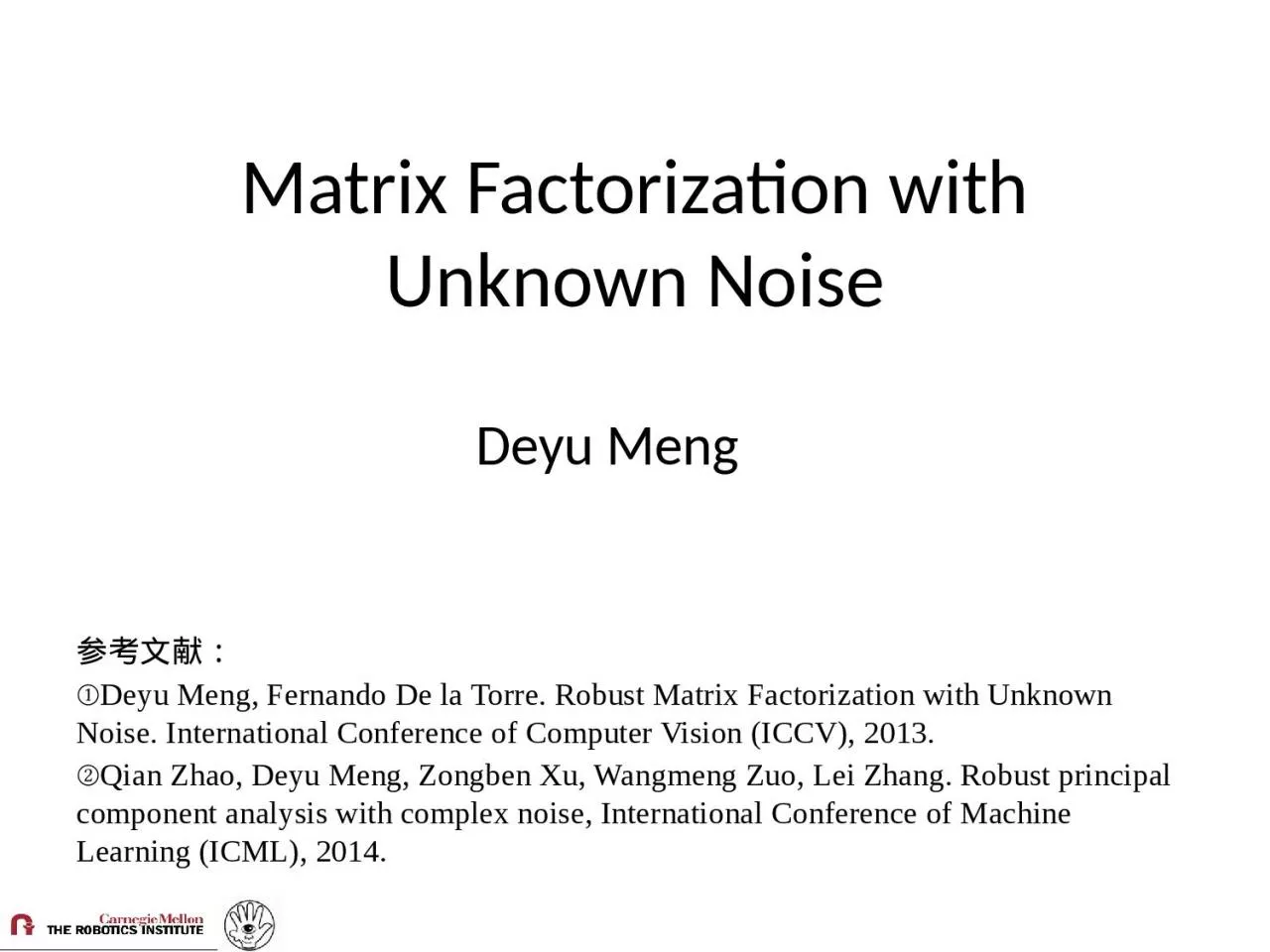

Deyu Meng 参考文献 Deyu Meng Fernando De la Torre Robust Matrix Factorization with Unknown Noise International Conference of Computer Vision ICCV 2013 Qian Zhao Deyu ID: 1037417
Download Presentation The PPT/PDF document "Matrix Factorization with Unknown Noise" is the property of its rightful owner. Permission is granted to download and print the materials on this web site for personal, non-commercial use only, and to display it on your personal computer provided you do not modify the materials and that you retain all copyright notices contained in the materials. By downloading content from our website, you accept the terms of this agreement.
1. Matrix Factorization with Unknown NoiseDeyu Meng 参考文献:Deyu Meng, Fernando De la Torre. Robust Matrix Factorization with Unknown Noise. International Conference of Computer Vision (ICCV), 2013.Qian Zhao, Deyu Meng, Zongben Xu, Wangmeng Zuo, Lei Zhang. Robust principal component analysis with complex noise, International Conference of Machine Learning (ICML), 2014.
2. Structure from Motion(E.g.,Eriksson and Hengel ,2010)Photometric Stereo(E.g., Zheng et al.,2012)Face Modeling(E.g., Candes et al.,2012)(E.g. Candes et al.,2012)Background SubtractionLow-rank matrix factorization are widely used in computer vision.
3. Complete, clean data (or with Gaussian noise)SVD: Global solution
4. Complete, clean data (or with Gaussian noise)SVD: Global solution There are always missing dataThere are always heavy and complex noise
5. L2 norm modelYoung diagram (CVPR, 2008) L2 Wiberg (IJCV, 2007) LM_S/LM_M (IJCV, 2008) SALS (CVIU, 2010) LRSDP (NIPS, 2010) Damped Wiberg (ICCV, 2011) Weighted SVD (Technometrics, 1979) WLRA (ICML, 2003) Damped Newton (CVPR, 2005) CWM (AAAI, 2013) Reg-ALM-L1 (CVPR, 2013)Pros: smooth model, faster algorithm, have global optimum for non-missing dataCons: not robust to heavy outliers
6. L2 norm modelL1 norm modelYoung diagram (CVPR, 2008) L2 Wiberg (IJCV, 2007) LM_S/LM_M (IJCV, 2008) SALS (CVIU, 2010) LRSDP (NIPS, 2010) Damped Wiberg (ICCV, 2011) Weighted SVD (Technometrics, 1979) WLRA (ICML, 2003) Damped Newton (CVPR, 2005) CWM (AAAI, 2013) Reg-ALM-L1 (CVPR, 2013) Torre&Black (ICCV, 2001) R1PCA (ICML, 2006) PCAL1 (PAMI, 2008) ALP/AQP (CVPR, 2005) L1Wiberg (CVPR, 2010, best paper award) RegL1ALM (CVPR, 2012)Pros: smooth model, faster algorithm, have global optimum for non-missing dataCons: not robust to heavy outliersPros: robust to extreme outliersCons: non-smooth model, slow algorithm, perform badly in Gaussian noise data
7. L2 model is optimal to Gaussian noise L1 model is optimal to Laplacian noiseBut real noise is generally neither Gaussian nor Laplacian
8. Saturation and shadow noiseCamera noise…Yale B faces:
9. We propose Mixture of Gaussian (MoG)Universal approximation property of MoGAny continuous distributionsMoGE.g., a Laplace distribution can be equivalently expressed as a scaled MoG (Maz’ya and Schmidt, 1996)(Andrews and Mallows, 1974)
10. MLE ModelUse EM algorithm to solve it!
11. E Step:M Step:
12.
13. Good measures to estimate groundtruth subspaceWhat L2 and L1 methods optimizeSynthetic experiments Six error measurementsThree noise casesGaussian noiseSparse noiseMixture noise
14. Gaussian noise experimentsSparse noise experimentsMixture noise experimentsL2 methodsL1 methodsOur method MoG performs similar with L2 methods, better than L1 methods. MoG performs as good as the best L1 method, better than L2 methods. MoG performs better than all L2 and L1 competing methods
15. Why MoG is robust to outliers? L1 methods perform well in outlier or heavy noise cases since it is a heavy-tail distribution. Through fitting the noise as two Gaussians, the obtained MoG distribution is also heavy tailed.
16. Face modeling experiments
17. ExplanationSaturation and shadow noiseCamera noise
18. Background Subtraction
19. Background Subtraction
20.
21.
22.
23.
24.
25.
26. SummaryWe propose a LRMF model with a Mixture of Gaussians (MoG) noiseThe new method can well handle outliers like L1-norm methods but using a more efficient way.The extracted noises are with certain physical meanings
27. Thanks!